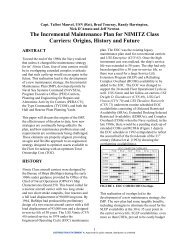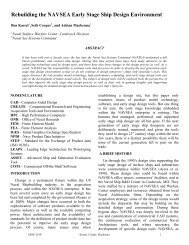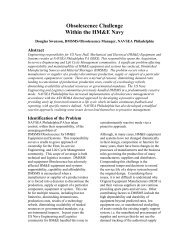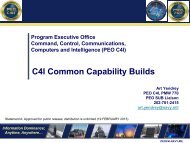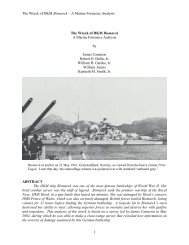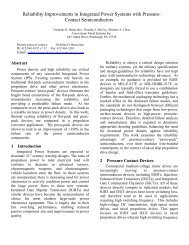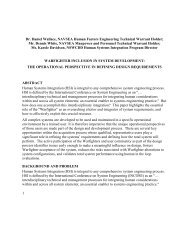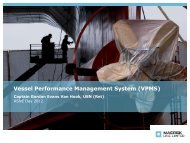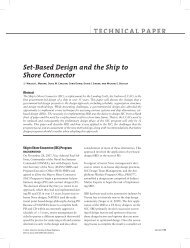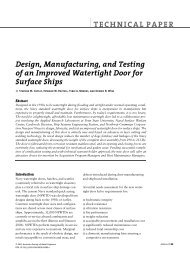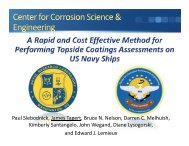Gray_Paper
Gray_Paper
Gray_Paper
You also want an ePaper? Increase the reach of your titles
YUMPU automatically turns print PDFs into web optimized ePapers that Google loves.
Distribution Statement A: Approved for Public Release; Distribution Unlimited<br />
Dr. Alexander <strong>Gray</strong> 1 , Brian Cuneo 2 , Dr. Nickolas Vlahopoulos 2 , Dr. David Singer 2<br />
1 NAVSEA Carderock, 2 University of Michigan<br />
The Rapid Ship Design Environment –<br />
Multi-Disciplinary Optimization of a U.S. Navy Frigate<br />
ABSTRACT<br />
Early-stage design decisions directly impact the<br />
ultimate quality and cost of a design. The goal<br />
of the U.S. Navy’s Rapid Ship Design<br />
Environment (RSDE) is to enhance early-stage<br />
ship design by utilizing higher fidelity design<br />
and analysis tools, earlier in the ship design<br />
process to intelligently search for an optimal<br />
ship design. In the RSDE, Multi-disciplinary<br />
optimization (MDO) will be utilized to link<br />
existing ship synthesis and analysis tools to<br />
create a design system capable of providing<br />
intelligent decision support. Knowledge is<br />
necessary to make intelligent decisions. RSDE<br />
applies MDO routines in such a way as to<br />
facilitate design space exploration (DSE) and<br />
utilization of design of experiments (DOE). By<br />
using a mixture of gradient and non-gradient<br />
based, discrete and continuous MDO<br />
methodologies, the RSDE will be capable of<br />
representing the inherent uncertainty of earlystage<br />
ship design requirements and design<br />
values. The use of DSE and uncertainty<br />
representation together will allow for a shift<br />
from the classical, point-based, design-spiral<br />
approach, towards a modern set-based design<br />
(SBD) approach for early-stage ship design.<br />
The focus of this paper will be the MDO<br />
capabilities within the RSDE.<br />
To date, a ship analysis Use Case has been<br />
developed to test the current RSDE MDO<br />
capabilities. The goal of the initial Use Case<br />
was to test the ability of RSDE to handle<br />
continuous design variables while developing a<br />
robust, optimal hullform. The MDO algorithms<br />
1<br />
utilized two discipline optimizations,<br />
minimizing lifetime power requirements and<br />
maximizing the percent time operational.<br />
Preliminary results have shown the MDO<br />
algorithms to be capable of reaching an optimal<br />
solution within the boundary of the stated Use<br />
Case. The RSDE will act as a foundation for the<br />
continued growth and development of a SBD<br />
capability for the U.S. Navy and will aid the<br />
workforce in producing more robust ship<br />
designs, reducing the need for costly late-stage<br />
design changes.<br />
INTRODUCTION<br />
As budgets continue to decrease and<br />
shipbuilding costs increase, it has become<br />
increasingly important to design ships that<br />
perform well for multiple mission scenarios.<br />
Designing these multi-mission, flexible, and<br />
highly robust ships requires a paradigm shift in<br />
the methodologies utilized for the ship design<br />
process itself. To successfully implement a<br />
change in design theology, the paradigm shift<br />
must begin as early-on as the concept design<br />
phase. Designers can no longer afford to follow<br />
the traditional design spiral approach, Fig. 1, of<br />
fixing a few key design parameters early-on and<br />
then immediately searching for a single feasible<br />
solution, entirely dependent on the initially<br />
selected key design values, to meet the design<br />
objectives.<br />
Historically, the point-based design method has<br />
resulted in a struggle to maintain a feasible<br />
design during detailed design, which in turn has
Distribution Statement A: Approved for Public Release; Distribution Unlimited<br />
led to compromised design objectives, costly<br />
late-stage design fixes, and sub-optimal ship<br />
designs balancing on the edge of feasibility.<br />
Fig. 2 shows a general description of how costs<br />
steadily increase throughout the life-cycle of a<br />
naval design project.<br />
Fig. 1 Classic Design Spiral for Point-Based<br />
Design [Evans 1959]<br />
Fig. 2 Design and Construction Life-Cycle<br />
Costs [Keane and Tibbitts 1996]<br />
Recently, the U.S. Navy has expressed interest<br />
in utilizing set-based design (SBD) to facilitate<br />
the necessary paradigm design shift [Kassel,<br />
Cooper, and Mackenna 2010; Eccles 2010;<br />
Doerry and Steding 2009; Sullivan, 2008;<br />
Singer, Doerry, and Buckley, 2010]. Set-based<br />
design is a design theory that encourages<br />
exhaustive investigation of a set of solutions and<br />
sets of design values during early-stage design.<br />
Bernstein [1998], provides an excellent<br />
2<br />
description of the intricate details of the SBD<br />
process and applications of SBD in industry.<br />
One key aspect of SBD theory is the intentional<br />
delay of early-stage design decisions until<br />
design trade-offs are fully understood, allowing<br />
for a gradual narrowing of the design space<br />
through the elimination of infeasible and less<br />
desirable design solutions [<strong>Gray</strong> 2011].<br />
Although paradoxical, research has shown that<br />
the SBD method of delaying decisions reduces<br />
costs by investing more resources up-front to<br />
perform DSE [Ward et al. 1995] . The benefits<br />
of the up-front time investment are an increase<br />
in knowledge and a decrease in uncertainty,<br />
enabling designers to make well-informed earlystage<br />
design decisions. Fig. 3, illustrates the<br />
changes in design knowledge and uncertainty<br />
over time and the points at which key earlystage<br />
decisions are made for the point-based and<br />
set-based design methods.<br />
Fig. 3 Key Decision Points for Point-Based<br />
and Set-Based Design Methods<br />
The influence of SBD theory on the design<br />
process is shown in Fig. 4. The figure illustrates<br />
how through the set-based practice of the<br />
delaying of design decisions, there is a parallel<br />
delay of committed costs, as well as a shift in the<br />
strength of managerial influence over the life of<br />
the project.<br />
The drawback of the SBD process is that many<br />
designers and engineers are so accustomed to<br />
utilizing the point-based design approach that<br />
the switch to a design method that relies upon
Distribution Statement A: Approved for Public Release; Distribution Unlimited<br />
the communication of information using sets of<br />
design values and solutions can be extremely<br />
difficult. Liker et. al., discuss the need for the<br />
development of design tools to, “facilitate a<br />
proper exchange of information”, including setbased<br />
information [1996]. This is where a<br />
design tool such as the rapid ship design<br />
environment (RSDE) comes into play.<br />
Fig. 4 Influence of Set-Based Design on the<br />
Design Development Process<br />
With the current push in the Navy to utilize SBD<br />
practices, and with the overall goal of RSDE in<br />
mind, a move to an integrated design framework<br />
is necessary. Fig. 5 shows the overall structure<br />
of the RSDE, within this framework various<br />
technologies are being developed in parallel.<br />
One part of the RSDE architecture currently<br />
undergoing testing is the Multi-Disciplinary<br />
Optimization (MDO) capability using the data<br />
structure provided by the Leading Edge<br />
Architecture for Prototyping Systems (LEAPS).<br />
Within the RSDE environment the ability to use<br />
MDO can help designers and functional design<br />
groups develop a better understanding of the<br />
design space. By identifying optimum values<br />
within a design space, the designers can narrow<br />
their search for preferred solutions, while also<br />
3<br />
gaining information about the space, all without<br />
requiring premature design decisions.<br />
Fig. 5 RSDE Hierarchy<br />
The MDO capabilities being developed for the<br />
RSDE will allow for rapid searching of design<br />
spaces while considering multiple design goals<br />
at the same time. Along with analyses tools<br />
compatible with LEAPS, the MDO abilities<br />
provides automated design space exploration<br />
using models that can contain both continuous<br />
and discrete design variables.<br />
Rapid Ship Design Environment<br />
SBD practice places an emphasis on making the<br />
right decisions the first time, as early decisions<br />
impact all subsequent design decisions, as well<br />
as the ultimate cost, delivery, produce-ability,<br />
and robustness of a design. To facilitate the<br />
SBD process, tools are needed to aid designers<br />
in generating information on design space tradeoffs<br />
during early-stage design and promoting<br />
communication of the information in a set-based<br />
manner [Liker, et. al., 1996].<br />
The Rapid Ship Design Environment (RSDE) is<br />
being developed by NAVSEA-Carderock under<br />
the CREATE-Ships Rapid Design Integration<br />
(RDI) program. RSDE is designed to harness<br />
physics based design tools to provide designers<br />
with a methodology to intelligently explore the<br />
design space and analyze design trade-offs.<br />
Specifically RSDE will utilize, the Advanced<br />
Ship and Submarine Evaluation Tool (ASSET)
Distribution Statement A: Approved for Public Release; Distribution Unlimited<br />
for design [ASSET 2012] and LEAPS for the<br />
aggregation of design data [LEAPS, 2012].<br />
In addition to the DOE capabilities of the RSDE,<br />
a decision support toolkit (DST) is being<br />
developed to provide information about the<br />
design space. The DST is designed to provide<br />
users with an array of multi-disciplinary<br />
optimization (MDO) methods, including<br />
gradient and non-gradient based methods for use<br />
with both discrete and continuous design<br />
variables. Some of the non-gradient based<br />
methods include the use of genetic algorithms<br />
and fuzzy logic methods. As a whole, the RSDE<br />
and the MDO methods provided by the DST<br />
should help to move the Navy towards meeting<br />
the goals outlined in the memorandum by<br />
Admiral Sullivan [2008], Commander of the<br />
Naval Sea Systems Command. The memo<br />
expressed a desire for ever more sophisticated<br />
design and analysis tools capable of facilitating<br />
advanced design methods.<br />
To support MDO in early-stage ship design, a<br />
decision support toolkit (DST) has been jointly<br />
developed by NAVSEA Carderock, Michigan<br />
Engineering Service, and the University of<br />
Michigan. The DST provides several methods<br />
of performing design optimization with the<br />
intent of providing information that can be used<br />
to make intelligent, informed design decisions.<br />
Currently the MDO portion of the DST contains<br />
optimization methods capable of performing<br />
discipline level and system level (MDO)<br />
optimizations using both discrete and continuous<br />
design variables.<br />
Four optimization methods have been developed<br />
within the DST to this point, one utilizing a<br />
gradient based algorithm called NEWSUMT<br />
[Miura and Schmit 1979], two using genetic<br />
algorithms referred to as the RGA [Deb, Dhiraj,<br />
and Ashish 2001] and NSGA2 [Deb et al. 2000]<br />
optimizers, and one fuzzy logic system [Mendel<br />
2001]. The remainder of this paper discusses the<br />
4<br />
work that has been completed on the MDO<br />
portion of the DST and an initial Use Case that<br />
was specifically developed to validate the<br />
performance of the discipline and system level<br />
MDO algorithms for continuous design<br />
variables.<br />
Multi-Disciplinary Optimization<br />
The desire for more cost effective ship designs<br />
has led to a push for multi-functional, multimission,<br />
robust ship design solutions. As a<br />
result, ship designs are now heavily influenced<br />
by multiple stakeholders each representing<br />
unique design disciplines, where each discipline<br />
has its own unique design goal(s). In these types<br />
of multi-disciplinary design environments, the<br />
unique goals of each discipline evoke a constant<br />
struggle for controlling influence of design<br />
parameters. MDO involves the attempt to use<br />
mathematical methods to develop an optimized<br />
solution for all participating design disciplines,<br />
while simultaneously taking into consideration<br />
the often competing and conflicting design goals<br />
of each discipline. MDO has been successfully<br />
used in many industries that involve the design<br />
of complex engineering systems including<br />
power generation [Wang and Singh 2006],<br />
aerospace [Kuan et al. 2010; Vlahopoulos,<br />
Zhang, and Sbragio 2011], automotive [H. M.<br />
Kim et al. 2002], and naval architecture<br />
[Hannapel and Vlahopoulos 2010; H. Y. Kim<br />
and Vlahopoulos 2012].<br />
The unique design goals of each design<br />
discipline result in equally unique discipline<br />
level optimization solutions. A discipline level<br />
optimization is defined as an optimization that<br />
considers the design goals of a single design<br />
discipline only, regardless of other disciplines.<br />
As an example, the optimization of a ship’s<br />
weight would likely result in different optimal<br />
solutions for the Stability, Resistance, and<br />
Survivability design disciplines. Applying an<br />
MDO to optimize the ship weight from a system
Distribution Statement A: Approved for Public Release; Distribution Unlimited<br />
level perspective, simultaneously considering<br />
the design goals of the all three unique<br />
disciplines, would likely result in yet another<br />
distinct optimal ship weight. Fig. 6 shows<br />
theoretical results of the discipline level, and<br />
system level (MDO) optimizations for a ship’s<br />
weight.<br />
Fig. 6 Example Results for Optimization of<br />
Ship Weight at the Discipline Levels and<br />
MDO System Level<br />
When the system level MDO solution is<br />
compared to the solution of a discipline level<br />
optimization, the MDO solution may appear to<br />
be sub-optimal compared to that one discipline.<br />
Consider the comparison of the Resistance<br />
discipline optimization versus the MDO result;<br />
Fig. 6. The higher weight of the system level<br />
MDO solution is due to the necessary<br />
compromises and design trade-offs the MDO<br />
makes to satisfy the added design disciplines of<br />
Stability and Survivability. The MDO develops<br />
a solution that is optimal when accounting for all<br />
discipline level design goals. As a result, the<br />
MDO solution may not be optimal for any one<br />
discipline, but it is optimal from a systems<br />
engineering viewpoint.<br />
A multi-level optimization approach is used in<br />
the DST to support MDO; Fig. 7. The bottom<br />
level of the MDO consists of individual<br />
discipline level optimizations. The discipline<br />
level optimizers pass information to the top,<br />
system level, optimization algorithm which<br />
combines the information to determine a single<br />
MDO result. The system level MDO result is<br />
5<br />
then passed back to the discipline level<br />
optimizers to influence the optimization search<br />
process. The swapping of information between<br />
the discipline levels and system level continues<br />
in an iterative fashion until the system level<br />
convergence criteria are met. Fig. 7 shows a<br />
diagram of the general operating procedure for<br />
the multi-level MDO approach.<br />
Fig. 7 Multi-Level, MDO Algorithm Search<br />
Process Diagram<br />
To date, two system level algorithms for use in a<br />
multi-level MDO problem have been<br />
implemented in the DST. Both algorithms were<br />
developed by Dr. Nick Vlahopoulos at<br />
University of Michigan and can be found in<br />
references [Hannapel and Vlahopoulos 2010]<br />
and [H. Y. Kim and Vlahopoulos 2012]. The<br />
system level algorithm used in the Use Case is<br />
described in [H. Y. Kim and Vlahopoulos 2012]<br />
and summarized below. This MDO system level<br />
algorithm scales each discipline by a Plausible<br />
Reduction Range (prr) to weight each discipline<br />
evenly. The prr for each discipline is calculated<br />
by finding the maximum difference between the<br />
discipline’s objective function optimum ( )<br />
,where are the design variable values for<br />
the optimum of discipline and the discipline<br />
objective value at the optimal design variable<br />
values of all other disciplines ( ). Show in<br />
equation 1.<br />
( ( ) )<br />
(1)<br />
During each iteration of the MDO, the current<br />
values of the design variables are used as<br />
starting points for each of the discipline level
Distribution Statement A: Approved for Public Release; Distribution Unlimited<br />
optimizations. The optimal values from each<br />
discipline are then located, communicated back<br />
to the system level optimizer, and used in the<br />
system level objective function shown in<br />
equation 2.<br />
( )<br />
(∑ ( ) )<br />
(2)<br />
The system level objective function<br />
represents the distance from the discipline<br />
optimum ( ) to the discipline value,<br />
( ), at the current design variable value(s) x,<br />
scaled by the . The system level optimization<br />
formulation is shown in equation 3.<br />
( )<br />
(3)<br />
In equation 3, represents the system<br />
level inequality constraints, which include any<br />
system level constraints, as well as all discipline<br />
level constraints. represents the system<br />
level equality constraints, which again contain<br />
all system and discipline level constraints.<br />
and are the lower and upper<br />
bounds of the variables, which take into account<br />
all system and discipline level bounds. The<br />
system level constraints and bounds consider all<br />
disciplines to ensure that the final optimum point<br />
is feasible for all disciplines involved.<br />
MDO Use Case Definition<br />
The goal of the first Use Case for the MDO<br />
portion of the DST was to demonstrate the MDO<br />
algorithms using all continuous variables. Use<br />
Case 1 (UC-1) conducts an optimization on the<br />
hydrodynamic performance of a surface<br />
combatant based on the hullform of the Oliver<br />
Hazard Perry (FFG 7). The hullform was<br />
optimized with respect to two design disciplines,<br />
minimizing the lifetime power requirements of<br />
6<br />
the ship, and maximizing the average percent<br />
time operational. Each discipline was subject to<br />
various constraints to ensure hydrostatic stability<br />
and feasible designs. The MDO formulation<br />
used 11 continuous design variables, which were<br />
inputs to the LEAPS Hullform Transformation<br />
Utility (HFT). The design variables listed in<br />
Tabel 1. Are all shape factors (SF) used by the<br />
HFT.<br />
Table 1: Design Variable List<br />
Design Variable<br />
Length<br />
Depth<br />
Beam<br />
Longitudinal Fullness Forward<br />
Longitudinal Fullness Aft<br />
Vertical Fullness Above WL<br />
Vertical Fullness Below WL<br />
Transverse Fullness<br />
Hullform Angle Bow<br />
Hullform Angle Stern<br />
Hullform Angle port/starboard<br />
The SF design variables manipulate the hull in<br />
multiple ways and all have values that range<br />
from -1 to 1. The parent hull is found when all<br />
SFs are set equal to zero. The dimensional SF<br />
(Length, Depth, and Beam) correspond to the<br />
respective values on the bounding box around<br />
the ship hull. The longitudinal fullness factors<br />
control what percentage of the ship hull fills the<br />
bounding box forward and aft of midships. The<br />
vertical fullness factors control what percentage<br />
of the ship hull fills the bounding box above and<br />
below the waterline, and the transverse fullness<br />
factor controls the port and starboard fullness<br />
with respect to the bounding box. The bow and<br />
stern angle controls the angle of the front and<br />
end of the bounding box respectively. Finally,<br />
the port/starboard angle controls the angles of<br />
the sides of the bounding box (see Hull Transfer<br />
Utility [2012] for more information). Fig. 8,<br />
shows pictures of the baseline hullform and<br />
transformed hullform utilizing SFs. In the
Distribution Statement A: Approved for Public Release; Distribution Unlimited<br />
optimization process the HFT is called to<br />
automatically shape the hullform for further<br />
7<br />
design analyses.<br />
Fig. 8 Demonstration of the Use of Shape Factors in the Hullform Transfer Utility<br />
The first of the two design disciplines attempts<br />
to minimize the lifetime power requirements of<br />
the ship. The lifetime power requirements are<br />
based on the KW-hours required to overcome<br />
the ships resistance at the speed profile given in<br />
Table 2. The ship was given an assumed ship<br />
time at sea of 4000 hours per year, and a ship<br />
service life of 30 years.<br />
Table 2: Speed Profile<br />
Ship Speed (knots) Time at Speed (%)<br />
10 50<br />
15 30<br />
20 15<br />
25 3<br />
30 2<br />
The analysis of the ship resistance at each speed<br />
was calculated using the LEAPS Total Ship<br />
Drag (TSD) program, which predicts the total<br />
ship resistance based on the methods described<br />
in, “Rapid Resistance Evaluation of High-Speed<br />
Ships” [Metcalf et al]. For each hull form<br />
analyzed by the optimizer, the resistance<br />
characteristics are found for each of the speeds<br />
listed in Table 2, with the results used in<br />
Equation 4. In Equation 4, N is the total number<br />
of speeds, TDi is the total drag at speed i in N,<br />
and Vi is the velocity at speed i in m/s. The<br />
number is converted to KW-hrs giving the<br />
objective function for the lifetime power<br />
minimizer, SLP.<br />
(∑<br />
)<br />
(4)<br />
The second discipline attempts to maximize the<br />
percent time operational (PTO) of the ship. The<br />
PTO is a function of the ship mission. For UC-<br />
1, the ship was assumed to be operational if it<br />
could launch and recover a helicopter. Table 3<br />
shows the upper limits on four motions which<br />
must be satisfied to complete helicopter<br />
operations.
Distribution Statement A: Approved for Public Release; Distribution Unlimited<br />
Table 3: Upper Limits on Motions for<br />
Helicopter Operations<br />
Motion Operational<br />
Limit<br />
Roll 8 [degrees]<br />
Pitch 3 [degrees]<br />
Vertical Acceleration 0.4 [g]<br />
Horizontal Acceleration 0.4 [g]<br />
To find the average PTO, the hullform was<br />
tested in a variety of sea states based on<br />
historical data to give a yearly wave profile in<br />
multiple locations. The analysis was conducted<br />
using the LEAPS Ship Motions Program (SMP).<br />
SMP calculates the ships motions using methods<br />
described in [Conrad 2005]. Using all of the<br />
yearly wave profiles available the resultant ship<br />
motions were inspected with respect to<br />
maximum pitch and roll values, and the vertical<br />
and horizontal acceleration at the helicopter<br />
deck. The helicopter deck was assumed to be<br />
located at 90% of the ship’s length overall. The<br />
average PTO was calculated to give the<br />
objective function value.<br />
For UC-1 both disciplines were subject to the<br />
same constraints. The constraints were designed<br />
to ensure that the ship was hydrostatically stable.<br />
The longitudinal center of buoyancy (LCB) was<br />
constrained to be within 0.5% of the length<br />
water line (LWL) to the longitudinal center of<br />
gravity (LCG). The ship GMT had to be greater<br />
than 10% of the beam (B). The final constraint<br />
for hydrostatics ensured that the weight of the<br />
ship was equal to the displacement .<br />
Additional constraints were used to simplify<br />
calculations. The vertical center of gravity<br />
(VCG) was constrained to be equal to 57% of<br />
the ship depth. The LCG was required to be 51%<br />
of the ship LWL. The weight of the ship was<br />
calculated based on the hull volume by using a<br />
ship density factor of 0.4 MT/m 3 . The final set<br />
of constraints ensured that the displacement of<br />
8<br />
the ship was between 4000 and 7000 metric<br />
tonnes. All constraints are shown in equations<br />
5-13.<br />
Due to limitations in the analysis software, for<br />
UC-1, genetic algorithm solvers were used for<br />
the optimization process. Different combinations<br />
of design variables caused irregular shapes<br />
which would fail to run in the analysis tools.<br />
This would lead to discontinuities in the design<br />
space, which would cause gradient based<br />
optimization solvers to give sub-optimal results.<br />
For all results presented below, the NSGA-II<br />
solver was used for both system and discipline<br />
level optimization solvers.<br />
Results<br />
(5)<br />
(6)<br />
(7)<br />
(8)<br />
(9)<br />
(10)<br />
(11)<br />
(12)<br />
(13)<br />
Although an exhaustive search of the design<br />
space has not been completed, the MDO portion<br />
of the DST displayed promising results. Using<br />
the NSGA-II solver, the DST was successfully<br />
run to pre-determined stopping criteria to select<br />
the “optimal” solution. When the MDO finished<br />
running, the results indicated an improvement in<br />
the objective function, showing that the process<br />
was moving in the correct direction towards an<br />
optimal solution.
Distribution Statement A: Approved for Public Release; Distribution Unlimited<br />
To analyze the optimization processes, first the<br />
parent hullform was optimized with respect to<br />
each of the individual disciplines. The parent<br />
hullform is shown in Fig. 9. The principal<br />
dimensions and values for lifetime power and<br />
PTO of the parent hullform are shown Table 4.<br />
Fig. 9 Parent Hullform (FFG 7)<br />
Table 4: Parent Hull Principle Dimensions<br />
and Objective Function Values<br />
LOA 127.63 [m]<br />
B 13.85 [m]<br />
T 5.07 [m]<br />
D 9.15 [m]<br />
L/B 9.22<br />
B/T 2.73<br />
B/D 1.51<br />
Lifetime Power 1,353,502 [kW-hr]<br />
PTO 32.2 [%]<br />
The results of the individual optimizations are<br />
shown below in Fig. 10 and Table 5 for the<br />
lifetime power minimization, and Fig. 11 and<br />
Table 6 for the average PTO maximization.<br />
Due to the shape factors used, some of the final<br />
hull forms seem unconventional. The use of the<br />
HFT is one aspect that makes this optimization<br />
problem unique, as most early stage design<br />
optimization processes are limited to only using<br />
parametric equations for analyses, or can only<br />
stretch/shrink a hull using parametric<br />
transformations. Even with the unique hull<br />
shapes, the trends that are shown follow a naval<br />
architect’s intuition to the individual optimums.<br />
In the case of the hullform that was optimized<br />
for lifetime power, the hull grew longer,<br />
approached the minimum displacement, and the<br />
9<br />
beam decreased. The average PTO<br />
maximization resulted in a hull with a greater<br />
displacement, and a very full ship under the<br />
waterline.<br />
Fig. 10 Lifetime Power Minimization<br />
Optimized Hullform<br />
Table 5: Lifetime Power Minimization<br />
Optimized Dimensions and Objective<br />
Function Values<br />
LOA 144.5 [m]<br />
B 13.4 [m]<br />
T 4.8 [m]<br />
D 8.9 [m]<br />
L/B 10.78<br />
B/T 2.79<br />
B/D 1.51<br />
Lifetime Power 1,211,480 [kW-hr]<br />
PTO 28.9 [%]<br />
Fig. 11 PTO Maximization Optimized Hullform<br />
Table 6: PTO Maximization Optimized<br />
Principal Dimensions and Objective Function<br />
Values<br />
L 123.9 [m]<br />
B 23.5 [m]<br />
T 7.9 [m]<br />
D 11.9 [m]<br />
L/B 5.27<br />
B/T 2.98<br />
B/D 1.98<br />
Lifetime Power 3,299,331 [kW-hr]<br />
PTO 45.8 [%]
Distribution Statement A: Approved for Public Release; Distribution Unlimited<br />
The ship was then optimized considering both<br />
disciplines’ objectives simultaneously using the<br />
in the complete MDO process. The results are<br />
shown in Fig. 12 and Table 7.<br />
Fig. 12 MDO Optimized Hullform<br />
Table 7: MDO Optimized Principal<br />
Dimensions and Objective Function Values<br />
L 172.5 [m]<br />
B 16.0 [m]<br />
T 3.95 [m]<br />
D 8.6 [m]<br />
L/B 10.78<br />
B/T 4.05<br />
B/D 1.86<br />
Lifetime Power 1,739,142 [kW-hr]<br />
PTO 41.2 [%]<br />
The results observed for the MDO showed<br />
improvement in the objective function for that<br />
process. When comparing the MDO results to<br />
the original hullform, the equal weighting of the<br />
disciplines is visible. The lifetime power<br />
requirements of the ship increased, while the<br />
PTO increased by a larger percentage than the<br />
percent increase of the lifetime power. When<br />
compared to the original parent hullform, the<br />
MDO optimized hullform experienced a 28.0%<br />
increase in lifetime power while the PTO was<br />
increased by 28.5%. Note that for lifetime<br />
power, a percent increase indicates a less<br />
favorable condition, whereas a percent decrease<br />
indicates a more favorable design, one using less<br />
power than the comparable hullform.<br />
The tradeoffs made by the MDO solution are<br />
also shown in comparing the solution to the<br />
lifetime power and PTO optimized solutions.<br />
The lifetime power for the MDO solution<br />
increased by 28.0% from parent hull, while the<br />
lifetime power optimized solution was able to<br />
10<br />
achieve a 10.2% decrease from the parent hull.<br />
However, the lifetime power optimized solution<br />
experienced a 10.5% decrease in PTO. The PTO<br />
of the MDO hull increased by 28.5% from the<br />
parent hull, while the PTO optimized hull form<br />
was able to increase by 42.2% from the parent<br />
hull. Table 8 shows the change in lifetime power<br />
and PTO for the MDO solution when compared<br />
to the parent and optimized hullform types using<br />
a percent error formula.<br />
Table 8: Percent Error of MDO, Lifetime Power<br />
Optimized, and PTO Optimized Solutions versus<br />
Parent Hullform<br />
Parameter Parent/<br />
Lifetime<br />
MDO<br />
Parent/<br />
LTP<br />
Parent/<br />
PTO<br />
Power (+)28.0% (-)10.2% (+)143%<br />
PTO (+)28.5% (-)10.5% (+)42.2%<br />
Conclusions<br />
The current status of the MDO capabilities<br />
within the DST show promising results even<br />
given the current limitations. The optimization<br />
algorithms have given correct results to test<br />
problems with known analytical solutions. In<br />
UC-1, the algorithms did move toward improved<br />
solutions, and in all optimizations, the objective<br />
function improved. Additionally, UC-1<br />
demonstrated how competing and conflicting<br />
design goals force a MDO solution to make<br />
design compromises that result in performance<br />
characteristics that are sub-optimal when<br />
compared to individual performance based<br />
optimizations. However, the results of the MDO<br />
solution are optimal when looking at the<br />
performance of the ship from a combined multidisciplinary<br />
systems view.<br />
Currently, improvements are being completed to<br />
allow for faster more complete optimization<br />
runs. A second use case is also being developed<br />
to test more capabilities of the DST. Use Case 2
Distribution Statement A: Approved for Public Release; Distribution Unlimited<br />
will test the DST’s ability to handle discrete<br />
design variables and will add an additional<br />
mission specific discipline, a high speed transit<br />
scenario.<br />
As the DST continues to grow capabilities, the<br />
overall goal is to integrate the DST into the<br />
RSDE. Within RSDE, the MDO capabilities can<br />
help lead engineers to regions of the design<br />
space with higher preferences. This can help for<br />
communicating preferences between design<br />
groups and facilitate the narrowing of the design<br />
space for SBD.<br />
References<br />
ASSET. 2012. “Ship Systems Integration and<br />
Design - ASSET.” Accessed October 12.<br />
http://www.navsea.navy.mil/nswc/cardcard<br />
e/pub/who/departments/asset.aspx .<br />
Bernstein, Joshua I. 1998. “Design Methods in<br />
the Aerospace Industry: Looking for<br />
Evidence of Set-Based Practices”.<br />
Massachusetts Institute of Technology.<br />
Conrad, Rielly E. 2005. SMP95: Standard Ship<br />
Motion Program Users Manual. West<br />
Bethesda.<br />
Deb, K., Joshi Dhiraj, and Anand Ashish. 2001.<br />
Real Coded Evolutionary Algorithms with<br />
Parent Centric Recombination. Kanpur.<br />
Deb, K., Amrit Pratap, Sameer Agarwal, and T.<br />
Meyarivan. 2000. A Fast and Elitist Multi-<br />
Objective Genetic Algorithm-NSGA-II.<br />
Kanpur.<br />
Doerry, N. Capt. USN, and M Steding. 2009.<br />
Ship Design Manager Manual.<br />
Eccles, T.J. Commander Naval Sea Systems<br />
Command. 29 Sept. 2010. Ship Design and<br />
Analysis Tool Goals. Ref. COMNAVSEA<br />
memo 9000 Ser 05T/015.<br />
11<br />
Evans, J. H. 1959. “Basic Design Concepts.”<br />
American Society of Navel Engineers<br />
Journal 711 (4): 672–678.<br />
<strong>Gray</strong>, Alexander Westley, “Enhancement of Set<br />
Based Design Practices Via Introduction of<br />
Uncertainty Through the Use of Interval<br />
Type 2 Modeling and General Type 2<br />
Fuzzy Logic Agent Based Methods”.<br />
University of Michigan, 2011.<br />
Hannapel, Shari, and Nickolas Vlahopoulos.<br />
2010. “Introducing Uncertainty in<br />
Multidiscipline Ship Design.” Naval<br />
Engineers Journal 122 (2) (June 7): 41–52.<br />
doi:10.1111/j.1559-3584.2010.00267.x.<br />
http://doi.wiley.com/10.1111/j.1559-<br />
3584.2010.00267.x.<br />
“Hull Transfer Utility”. West Bethesda: Naval<br />
Surface Warfare Center, Carderock<br />
Division, 2012.<br />
Kassel, B., S. Cooper, and A. Mackenna. 2010.<br />
“Rebuilding the NAVSEA Early Stage<br />
Ship Design Environment.” In American<br />
Society of Navel Engineers Day, 1–12.<br />
Keane, R. G. Jr., and B. F. Tibbitts. 1996. “A<br />
Revolution in Warship Design: Navy-<br />
Industry Integrated Product Teams.”<br />
Journal of Ship Production 12 (4): 254–<br />
268.<br />
Kim, H.M., Michael Kokkolaras, L.S. Louca,<br />
G.J. Delagrammatikas, N.F. Michelena,<br />
Z.S. Filipi, Panos Y Papalambros, J.L.<br />
Stein, and D.N. Assanis. 2002. “Target<br />
Cascading in Vehicle Redesign: a Class VI<br />
Truck Study.” International Journal of<br />
Vehicle Design 29 (3): 199–225.<br />
Kim, Hong Yoon, and Nickolas Vlahopoulos.<br />
2012. “A Multi-Level Optimization<br />
Algorithm and a Ship Design Application.”<br />
The American Institute of Aeronautics and<br />
Astronautics: 1–16.<br />
Kuan, Hu, Song Bifeng, Zhan Lin, Li Zhenliang,<br />
and Chang Xinlong. 2010. “MDO
Distribution Statement A: Approved for Public Release; Distribution Unlimited<br />
Application in Solid Rocket Motor<br />
Design.” In 2010 2nd IEEE International<br />
Conference on Information Management<br />
and Engineering, 249–253. Ieee.<br />
doi:10.1109/ICIME.2010.5478347.<br />
http://ieeexplore.ieee.org/lpdocs/epic03/wr<br />
apper.htm?arnumber=5478347.<br />
LEAPS, Ship Systems Integration and Design -<br />
LEAPS, Retrieved Oct. 11, 2012, from<br />
http://www.navsea.navy.mil/nswc/carderoc<br />
k/pub/who/departments/leaps.aspx<br />
Liker, J. K., Sobek, D. K., Ward, A. C., and<br />
Cristiano, J. J., "Involving Suppliers in<br />
Product Development in the United States<br />
and Japan: Evidence for Set-Based<br />
Concurrent Engineering", IEEE<br />
Transactions on Engineering Management,<br />
Vol. 43, No. 2, May 1996, pp. 165-178.<br />
Mendal, J. M., Uncertain Rule-Based Fuzzy<br />
Logic Systems, Introduction and New<br />
Directions, Prentice Hall PTR, Upper<br />
Saddle River, NJ, 2001.<br />
Metcalf, B. J., J. A. Grabeel, G. Karafiath, D. M.<br />
Hendrix, and F. L. Noblesse. Rapid<br />
Resistance Evaluation of High-Speed<br />
Ships. West Bethesda.<br />
Miura, Hirokazu, and Lucien A. Schmit. 1979.<br />
NEWSUMT - A Fortran Program for<br />
Inequality Constrained Function<br />
Minimization. Los Angeles.<br />
Singer, D. J., Captain N. Doerry, M. E. Buckley,<br />
"What is Set-Based Design?", Naval<br />
Engineering Journal, Vol. 121, No. 4,<br />
April, 2010.<br />
Sullivan, P.E., Commander, Naval Sea Systems<br />
Command, "Ship Design and Analysis<br />
Tool Goals", Ref: COMNAVSEA memo<br />
9000 Ser 05D/047, 4 Feb. 2008.<br />
Vlahopoulos, Nickolas, Geng Zhang, and<br />
Ricardo Sbragio. 2011. “Design of<br />
Rotorcraft Gearbox Foundation for<br />
Reduced Vibration and Increased<br />
12<br />
Crashworthiness Characteristics.” SAE<br />
International. doi:10.4271/2011-01-1704.<br />
Wang, L, and C Singh. 2006. “PSO-based<br />
Multidisciplinary Design of a Hybrid<br />
Power Generation System with Statistical<br />
Models of Wind Speed and Solar<br />
Insolation.” Power Electronics, Drives and<br />
Energy … 00 (Dc): 20–25.<br />
http://ieeexplore.ieee.org/xpls/abs_all.jsp?a<br />
rnumber=4147980.<br />
Ward, Allen, JK Liker, JJ Cristiano, and DK<br />
Sobek. 1995. “The Second Toyota<br />
Paradox: How Delaying Decisions Can<br />
Make Better Cars Faster.” Sloan<br />
Management Review 36 (2): 43–61.<br />
http://www.columbia.edu/itc/sociology/wat<br />
ts/g9058/client_edit/ward_et_al.pdf.<br />
Author Biographies<br />
Alexander <strong>Gray</strong> graduated with his Ph.D. in<br />
Naval Architecture and Marine Engineering<br />
(NA&ME), from the University of Michigan in<br />
2011. He now works as an engineer at<br />
NAVSEA, Carderock. He holds master’s<br />
degrees in Industrial operations engineering and<br />
NA&ME, as well as bachelor’s degrees in<br />
Mechanical and Aerospace engineering. His<br />
research interests include fuzzy logic,<br />
optimization, and set-based design theory.<br />
Brian Cuneo is a Ph.D. Candidate at the<br />
University of Michigan in the department of<br />
Naval Architecture and Marine Engineering. He<br />
has earned a BSE and MEng in the same major<br />
from the University of Michigan. Brian is<br />
currently a Research Assistant working with<br />
NAVSEA Carderock Division on a Naval<br />
Design Optimization Project. His current<br />
research is on developing a heuristic method of<br />
Multi-Disciplinary Design Optimization using<br />
methodologies from Hierarchical Fuzzy Logic<br />
Controllers.<br />
Nick Vlahopoulos is a Professor in the<br />
Department of Naval Architecture and Marine
Distribution Statement A: Approved for Public Release; Distribution Unlimited<br />
Engineering at the University of Michigan. He<br />
joined the University of Michigan in 1996 after<br />
working in the Industry for seven years. He has<br />
graduated 15 Ph.D. students, published 70<br />
journal papers and over 80 conference papers.<br />
The areas of his research are: numerical methods<br />
in structural-acoustics, and design of complex<br />
systems.<br />
David J. Singer is an Assistant Professor in the<br />
Department of Naval Architecture and Marine<br />
Engineering (NAME) at the University of<br />
Michigan. Dr. Singer obtained a B.S.E. degree<br />
in NAME, M.Eng. degree in Concurrent Marine<br />
Design, M.S.E. degree in Industrial and<br />
Operations Engineering and a PhD in NAME,<br />
all from the University of Michigan.<br />
13



